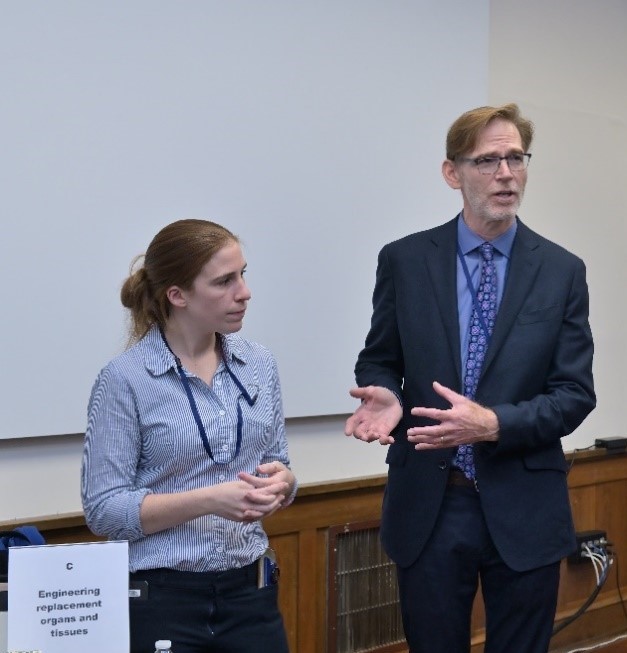
Named a TED Fellow and to Forbes’ 30 Under 30 list in Science are just two of Kaitlyn Sadtler’s, Ph.D., accomplishments that were achieved all before starting her independent research program at the National Institute for Biomedical Imaging and Bioengineering (NIBIB). Sadtler joined NIBIB as an Earl Stadtman Tenure-Track Investigator and Chief of the Section for Immunoengineering in 2019. “It’s hard to pinpoint the exact moment I realized I liked science. I think it relates to my love for puzzles – and science is one giant, ever-evolving puzzle,” Sadtler mused.
Sadtler didn’t come from a family of scientists – her father was a military veteran that worked for IBM and her mother was a teacher. She was the first in her family to obtain a Ph.D. She had a mentor early on that recognized her intelligence and ambition, and expressed to her that he believed she would graduate from a top ten graduate school with a Ph.D. “I thought he was crazy and that I’d never even attend a graduate school, let alone graduate from one,” screamed her imposter syndrome.
She tracked the start of her research career back to a postbaccalaureate Intramural Training Research Award fellowship in the Laboratory of Cellular and Molecular Immunology at the National Institute of Allergy and Infectious Diseases. “During my time there, I caught the immunology bug,” Sadtler recounted.
Following her postbac, Sadtler started her Ph.D. in the Cellular and Molecular Medicine program at Johns Hopkins University School of Medicine. The program was broadly focused on translational medical research and not focused on a specific discipline. Looking back, she feels lucky the program didn’t isolate her into one particular field and allowed her flexibility to study her interests in both immunology and engineering.
Sadtler completed her Ph.D. in just three and a half short years, with a publication in Science, a top scientific journal with one of the highest impact ratings. For comparison, the Survey of Earned Doctorates conducted by the National Science Foundation reported the average length of a Ph.D. degree was 5.8 years. Sadtler’s Science publication described which immune cells were most important to materials used in regenerative medicine.
In her postdoc, she wanted to hone her skills in the engineering and design of materials. She landed herself a postdoc at Massachusetts Institute of Technology (MIT) in the world-renowned engineering labs of NIBIB grantee Dr. Robert Langer and Dr. Daniel Anderson.
At MIT, she engineered and analyzed new materials to make medical devices more compatible to the human body. She explained that the human immune system could attack implanted medical devices such as a pacemaker, because they are identified as foreign material. This can create scarring around the device and sometimes interfere with its function.
When Sadtler began her training, there were very few basic immunologists working in tissue engineering and regenerative medicine. “I’m well versed in immunology and engineering. Communication is key in science, and I can converse in each of these complex topics with the top experts to make a greater impact,” she said. As the Chief of the Immunoengineering Section at NIBIB, Sadtler is continuing to develop new biomaterials for regenerative medicine. She is also using her experience in immunology to study wound healing and tissue growth.
As Sadtler is launching her new lab program at NIH, she realizes she has come full circle and is now on the flip side of the postbac interview, as the interviewer. Sadtler said she often answers several questions about what it’s like to be a postbac at NIH and reminisces on her experience as an alumna. She mentioned the prevalence of imposter syndrome in society and how meaningful it is to communicate with students that you were in their shoes once. Sadtler emphasizes to her interviewees, “I did it, and so can you.”
Sadtler cautioned that not all her memories about training and science are positive. She described several experiences where she was mistreated because she was a woman. “I’ve had moments when I have wanted to quit science,” Sadtler revealed.
She recounted an experience when she was a young, impressionable student working on an experiment in the lab and was confronted by an older male who told her that science was not meant for women. He recommended that she would be better off pursuing a career as a psychologist and should leave the lab science to men. “He was never reprimanded for his behavior, and I was shifted somewhere else in the lab to minimize our interactions, which was better for me, but didn’t prevent the same thing from happening again.”
Sadtler believes that the culture in science is undergoing a transformation, and it will take time, but she has seen the progress. She advised women in science and engineering fields to remember that science has its ups and downs, like life. “You may experience bias, but don’t let those moments define you. Build your support networks inside and outside of the lab to get through the tough times,” Sadtler opined.
Find more inspiring stories from NIBIB's women grantees at the WISE homepage.
